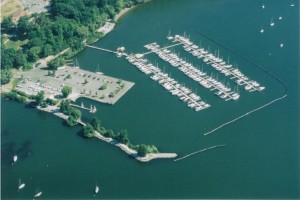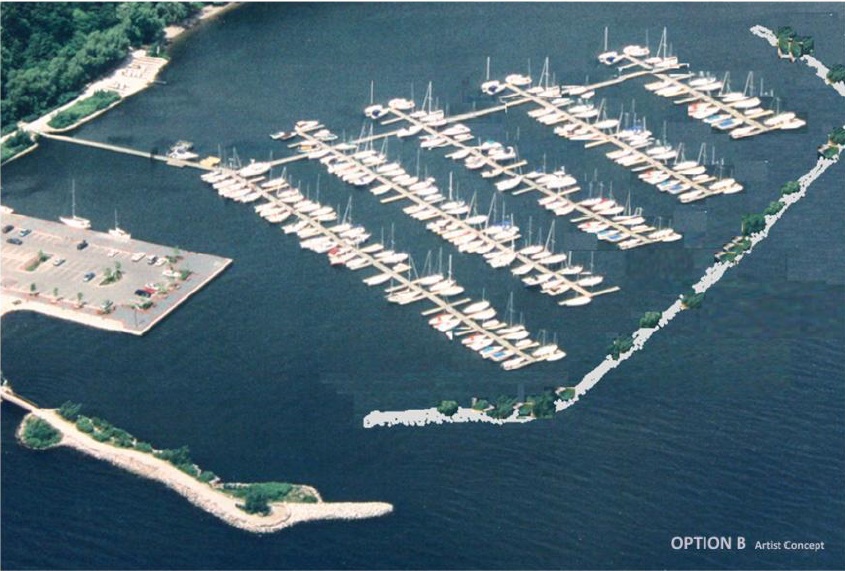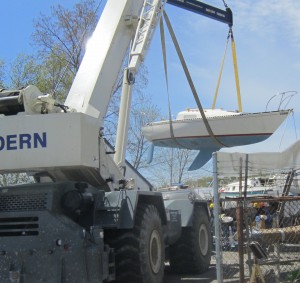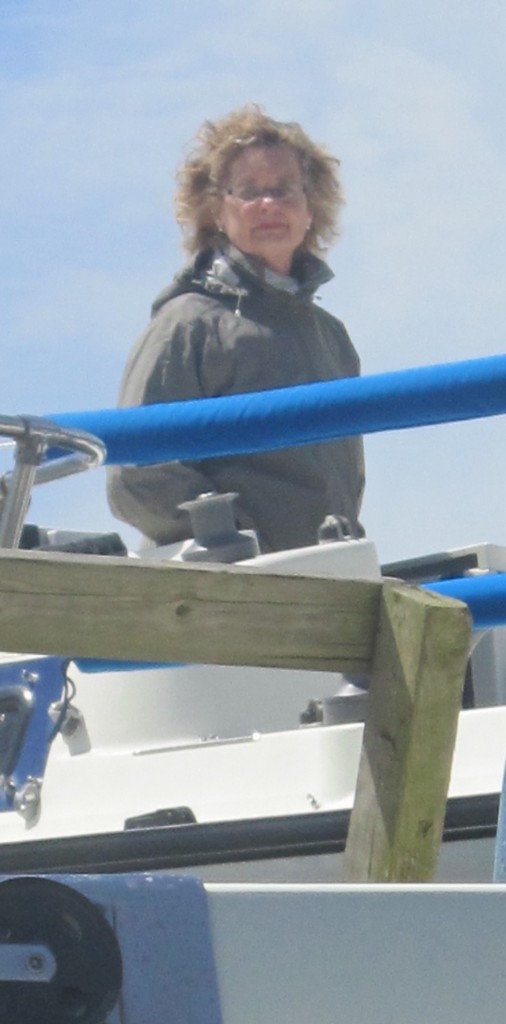By Pepper Parr
BURLINGTON, ON May 15, 2012 It’s a laudable objective – have the public marina at LaSalle Park become the 400th Safe Harbour in Ontario. Burlington is one of the very last communities on Lake Ontario to have a Safe Harbour – and given that we are the Second Best City in Canada to live in – a Safe Harbour would seem essential.

LaSalle Park Marina as it looks today - 219 slips with wave breaker and docks that have to be brought ashore every winter.
For John Birch it is more than essential – a Safe Harbour out at LaSalle Park is an opportunity to add to the goals of the fisheries people, especially the Hamilton Harbour and Watershed Fisheries Management Plan. Given all the toxic waste Hamilton has created in this end of Lake Ontario getting new fish species in the water is far more than a laudable goal – it’s an essential one.
And that is where Birch has been steering his boat for the past couple of years. By advocating for a form of wave barrier that will result in a Safe Harbour, Birch envisions 1,500 linear feet of an environmentally friendly, state of the art, riparian rock island fish and wildlife habitat wave breaker that will provide all weather protection for the city’s marina. It is a bold step.
The LaSalle Park Marina Association operates the marina at the foot of LaSalle Park and has done so since 1981 without so much as a dime of city money. “We are a non-profit that built this facility from scratch and have it to the point where there are 219 slips available to members of the Burlington Boating and Sailing Club. There is a boat launching ramp for public use as well.
The Marina currently has 219 slips. The docks have to be brought ashore every winter and the current wave reduction system doesn’t work particularly well. The LPMA wants to have a riparian rock island fish and wildlife habitat wave breaker built at a cost of $7 million that Birch expects to see paid for much the same way they built what they have today: a significant portion from the federal government with a close to matching amount from the provincial government and the rest coming from the association through some form of debenture they will pay off over time.

The option the LaSalle Park Marina Association hopes is chosen through the Environmental Assessment due March 2013. The design will add 100 slips plus 20 available for transient use and more significantly provide a solid barrier that will allow fish stocks to return and breed and put an end to the wave agitation
The Association has to be one of the gems for the city to work with. Founded in 1981 the LPMA put together a joint venture with the city that works this way. The land is owned by the city of Hamilton and is leased by Burlington and then sub-let to the LPMA. In 1998 LPMA borrowed $250,000 from the city as part of their joint venture agreement and built a new wave breaker that has a 20 year life span. That loan was fully retired in 2008 – without a payment being missed. The city now has a marina on land they lease and operated by the LPMA. Close to 90% of the lease expense is paid by the LPMA and the Burlington Boating and Sailing Club – the city picks up 10% which pays for the public ramp.
While the wave reduction devices help – they aren’t up to the job of preventing significant damage to boats tied up in the 219 slips.
The demand for additional slips is consistent. The Association turns people away every year and don’t expect to have any problems renting out the additional 100 slips that will become available when the project is completed.
The association saw an opportunity to take their two needs and add to them a third – a significant environmental improvement and improving the fish habitat in the area – the result being what the LPMA hopes will become Ontario’s 400th Safe Harbour.
All hinges on a positive environmental Assessment which the LPMA expects to see completed by March of 2013. Birch believes there are funds available for a project like the one they are proposing and that those funds will be spent somewhere – he just wants to see them spent in Burlington.

Another boat is hoisted out of the yard and into the water as the LaSalle Park Marina opens for another season.
The LPMA is confident that they can continue to operate what can only be described as a very successful business model. The club provides an excellent marina to the city and is debt free. It believe it will be able to bear its share of the $ 7 million it is going to cost to get the barrier in place and their hope is that the Environmental Assessment decision is for the option they have chosen.
They expect that the province will pick up 25% of the cost and the federal government an additional 25%. With LPMA picking up the balance.
This is one of those Mother of all Stakeholder partnerships. There is the MOE, the MNR, the COB, CH, the TSP people and BARC plus DOF, to name some of the people who will sit at this table. All have to be placated and accommodated.
There are several options before the various levels of government. The details are a little on the mundane side unless you sit on the LPMA Board. The option the association likes is one that will provide everything the sailors want and given that they are going to end up paying the lion’s share of the cost – one would think the governments involved will decide in their favour.


















